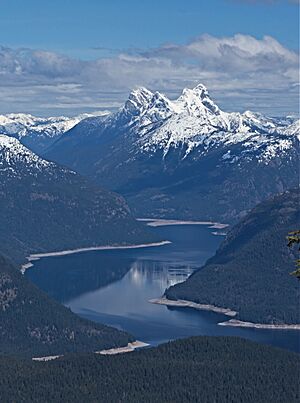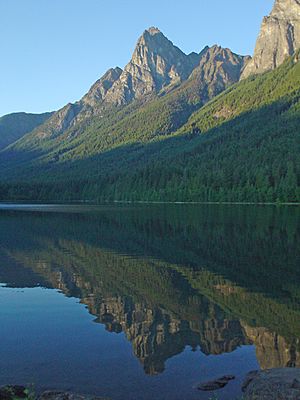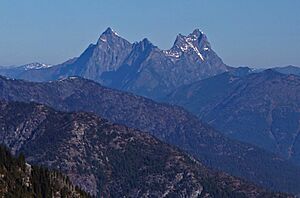Hozomeen Mountain facts for kids
Quick facts for kids Hozomeen Mountain, North Peak |
|
|---|---|

Hozomeen Mountain
|
|
| Highest point | |
| Elevation | 8,071 ft (2,460 m) NAVD 88 |
| Prominence | 3,932 ft (1,198 m) |
| Geography | |
| Location | Whatcom County, Washington, U.S. |
| Parent range | North Cascades |
| Topo map | USGS Hozomeen Mountain |
| Climbing | |
| First ascent | September 6, 1904 by Sledge Tatum, George E. Loudon, Jr. |
| Easiest route | class 4 snow/rock scramble |
Hozomeen Mountain is a tall, rocky mountain with two main tops, or "summits." It stands proudly on the east side of Ross Lake in the North Cascades area of Washington state. Even though it's not the highest mountain around, it's famous for how steeply its sides drop down from both of its summits. This makes it look very dramatic!
The Story Behind Hozomeen Mountain's Name
The name "Hozomeen" comes from the Salish language. This language was spoken by many Native American groups in what is now southern British Columbia and northern Washington State.
The name first appeared on a map made around 1857-1860. This map was drawn by Thiusoloc, a Salish guide for a land surveyor named Henry Custer. Thiusoloc helped record many Salish place names on the map.
According to Annie York, a native Salish speaker, "Hozomeen" means "sharp, like a sharp knife." This name is connected to a very old tradition. For about 9,000 years, local Native American people used a special rock called Hozomeen chert. This rock is like flint and was used to make tools for hunting and daily life.
Hozomeen North Peak: The Main Summit
The North Peak is the main and highest summit of Hozomeen Mountain. It was first climbed on September 6, 1904. The brave climbers were Sledge Tatum and George E. Loudon, Jr. They were part of a group surveying the border.
This North Peak is known as Washington's fourth steepest mountain. Its sides drop very sharply from the top!
Hozomeen South Peak: A Very Steep Challenge
The South Peak is about one mile southeast of the North Peak. It's a bit lower, but it's incredibly steep! Its north side is almost completely straight up for 1,000 feet.
This makes the South Peak the steepest mountain in Washington. It was first climbed on May 30, 1947. A team of six climbers made this first ascent. They were Fred Beckey, Melvin Marcus, Jerry O'Neil, Ken Prestrud, Herb Staley, and Charles Welsh.
Hozomeen South-west Peak: A Smaller, Steep Top
The South-west Peak is a smaller, steep part of Hozomeen Mountain. It was first climbed in 1951 by John Dudra and Howard Rode. The easiest way to climb it involves a rocky ridge and a gully. Its steepest side is the northwest face.
Hozomeen in Books and Stories
Hozomeen Mountain is also famous for being mentioned in books! It appears often in two novels by the writer Jack Kerouac. These books are The Dharma Bums (from 1958) and Desolation Angels (from 1965).
In these stories, the main characters are working at a fire lookout station on a nearby mountain called Desolation Peak. They often look out at Hozomeen Mountain.
There's even a rhyme about it in The Dharma Bums: "Hozomeen, Hozomeen, the most mournful mountain I've ever seen."
Climbing Hozomeen: Popular Routes
Climbers enjoy Hozomeen Mountain because it offers many challenging routes. Here are some of the well-known ways to reach its summits:
Routes on Hozomeen North
- The North Route is a common way to climb.
- The Northeast Buttress was the path taken by the first climbers, Sledge Tatum and George E. Loudon Jr., in 1904.
- The South Ridge is another popular choice.
- The Southwest Buttress is known for being very difficult to climb.
- The West Face is also considered one of the hardest routes.
Routes on Hozomeen South
- The Southwest Route was the first path taken by Fred Beckey and his team in 1947.
- The North Ridge was first climbed in 1974.
- The Southeast Buttress is another route.
Routes on Hozomeen South-west
- The Southwest Route was the first way up for John Dudra and Howard Rode in 1951.
- The South Ridge is a route with some exposed sections.
- The West buttress and face is another challenging climb.




